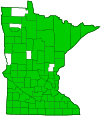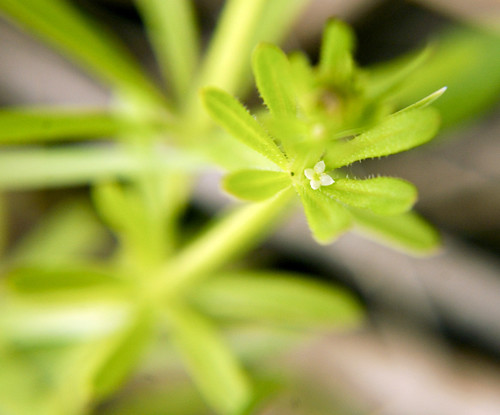cleavers
(Galium aparine)
Conservation • Wetland • Description • Habitat • Ecology • Use • Distribution • Taxonomy
Description |
||
Cleavers is an exotic, weedy, weak-stemmed, herbaceous plant. The nativity of cleavers is a matter of some debate. Some sources maintain that it is native to Europe, Asia, and North Africa, and that it has been introduced sporadically into North America. Most sources consider it to be native to North America. The Germplasm Resource Information Network (GRIN) shows it native in North America only in Alabama, naturalized elsewhere. Either way, it now occurs in every state in the United States, including Alaska and Hawaii, in every bordering Canadian province, in Mexico, and in South America. Cleavers is a 4″ to 40″ long, more or less scrambling, annual forb that rises on multiple stems from shallow roots. The stems are scrambling, slender, weak, 4-angled, hollow, and usually profusely branched. The angles have short, stiff, hooked, downward-pointing hairs. The leaves are in stalkless and in whorls of usually 8, sometimes 6 or 7. The blades are linear or linear inversely lance-shaped, ⅜″ to 3″ long, and less than ⅓″ wide. They have a single prominent vein running from the base to the tip. There is an abrupt, short, sharp, firm point at the tip. The upper surface is rough with firm, stiff, hooked hairs. The lower surface has short, stiff, backward-pointing hairs on the midvein. The margins are untoothed and have short, stiff, backward-pointing hairs. The inflorescences are clusters of 3 to 5 flowers rising directly from upper leaf axils, and sometimes an elongated stalk that rises from an upper leaf axil and has several clusters. The flowers are about ⅛″ wide. They consist of 4 white petals with pointed tips, 4 sepals that are shorter than the petals, 4 short stamens, and 2 short, pale yellow styles. There are 2 carpels at the base of the flower. The carpels are joined together, green, and covered with stiff, hooked hairs. The fruit is a grayish-brown, ball-like carpel, joined in pairs, usually covered with hooked hairs, rarely hairless, containing 1 seed. |
||
Height |
||
Scrambling, 4″ to 40″ long |
||
Flower Color |
||
White |
||
Similar Species |
||
False baby’s breath (Galium mollugo) also has leaves in whorls of 6 to 8. However, the stem, leaves, and carpels are hairless. The inflorescence has many flowers and is larger, highly branched, and showy. The flowers are larger. In Minnesota it has been recorded only in St. Louis County. Rough bedstraw (Galium asprellum) has many branches. The leaves on the stem are in whorls of 6, those on the branches in whorls of 4 or 5. |
||
Habitat |
||
Moist. Woods. Shade. |
||
Ecology |
||
Flowering |
||
June to August |
||
Pests and Diseases |
||
|
||
Use |
||
|
||
Distribution |
||||
|
Sources |
|||
| 3/24/2023 | ||||
Nativity |
||||
Native |
||||
Occurrence |
||||
Very common |
||||
Taxonomy |
|||
| Kingdom | Plantae (Plants) | ||
| Division | Tracheophyta (Vascular Plants) | ||
| Subdivision | Spermatophytina (Seed Plants) | ||
| Class | Magnoliopsida (Dicots) | ||
Order |
Gentianales (Gentians, Dogbanes, Madders, and Allies) | ||
Family |
Rubiaceae (madder) | ||
| Subfamily | Rubioideae | ||
| Tribe | Rubieae | ||
Genus |
Galium (bedstraws) | ||
Subordinate Taxa |
|||
|
|||
Synonyms |
|||
Galium agreste var. echinospermum Galium aparine var. echinospermum Galium aparine var. intermedium Galium aparine var. minor Galium aparine var. vaillantii Galium spurium var. echinospermum Galium spurium var. vaillantii Galium spurium var. vaillantii Galium vaillantii |
|||
Common Names |
|||
annual bedstraw bedstraw catch-weed bedstraw catchweed bedstraw cleavers cleaverwort goose grass goose-grass scarthgrass sticky-willy stickywilly white hedge |
|||
The hooked hairs on the leaves and stem grab onto (cleave to) clothing, bird feathers, and animal fur, giving this plant it’s common name. |
|||
Glossary
Axil
The upper angle where the leaf stalk meets the stem.
Carpel
The female reproductive organ of a flower, consisting of an ovary, styles, and stigmas.
Scrambling
Climbing awkwardly over adjacent vegetation or structures.
Sepal
An outer floral leaf, usually green but sometimes colored, at the base of a flower.
Visitor Photos |
|||||
Share your photo of this plant. |
|||||
| This button not working for you? Simply email us at info@MinnesotaSeasons.com. Attach one or more photos and, if you like, a caption. |
|||||
|
|||||
MinnesotaSeasons.com Photos |
|||||
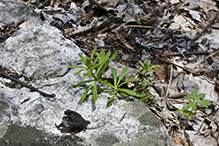 |
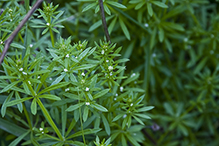 |
||||
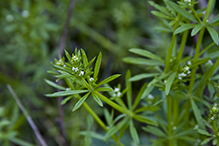 |
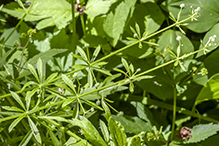 |
||||

Visitor Videos |
|||
Share your video of this plant. |
|||
| This button not working for you? Simply email us at info@MinnesotaSeasons.com. Attach a video, a YouTube link, or a cloud storage link. |
|||
Other Videos |
|||
| Edible plants Cleavers Galium aparine MiWilderness |
|||
About
Uploaded on May 28, 2011 Cleavers have had many uses throughout history. Here are the main features for identification and to distinguish Cleavers from close impostors. |
|||
| Cleavers (Galium Aparine) / Stickywilly - 2012-06-23 W3stlander |
|||
About
Published on Jun 25, 2012 Galium aparine is a herbaceous annual plant of the family Rubiaceae. It is native to North America and Eurasia. It has several common names, including Cleavers, Clivers, Goosegrass, Stickywilly, Sticky willow, Stickyjack, Stickyweed, Stickyleaf, Catchweed, Robin-run-the-hedge, Coachweed, and Bedstraw. --------------------- |
|||

Visitor Sightings |
|||||
Report a sighting of this plant. |
|||||
| This button not working for you? Simply email us at info@MinnesotaSeasons.com. Be sure to include a location. |
|||||
|
|||||
MinnesotaSeasons.com Sightings |
|||||
Avon Hills Forest SNA, North Unit Bertram Chain of Lakes Regional Park Carpenter St. Croix Valley Nature Center Clifton E. French Regional Park Forestville/Mystery Cave State Park Hardscrabble Woods / MG Tusler Sanctuary John Peter Hoffman Spring Brook Valley WMA Lake Alexander Woods SNA, South Unit Mary Schmidt Crawford Woods SNA Minnesota Valley NWR, Black Dog Unit Minnesota Valley State Recreation Area, Lawrence Unit Mound Spring Prairie SNA, North Unit Nerstrand Big Woods State Park P.N. and G.M. Nelson Wildlife Sanctuary Prairie Creek WMA, Koester Prairie Unit Robert Ney Memorial Park Reserve Spring Beauty Northern Hardwoods SNA Stanley Eddy Memorial Park Reserve |
|||||

|
Created: Last Updated: © MinnesotaSeasons.com. All rights reserved. |
